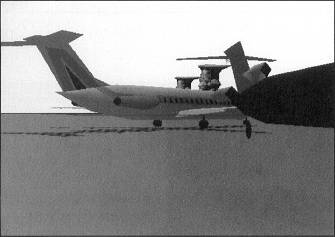Microsoft Flight Simulator Handbook
by Jonathan M. Stern
Departure Control
Departure Control is usually a radar controller in a TRACON (terminal radar approach control facility). See Figure 11.3.

The function of the departure controller is to provide initial aircraft separation and guidance as the aircraft flies through airspace in the vicinity of the airport, control of which has been delegated to the terminal facility by the Air Route Traffic Control Center (ARTCC). (See Figure 11.4.)

"Pittsburgh Departure Control, Lear 12345 is with you leaving two thousand three hundred for five thousand."
It is necessary to give the first radar controller your altitude on initial contact so that she may confirm that the Mode C (the altitude reporting function) readout is accurate within 300 feet. Mode C is that portion of the transponder that transmits the aircraft's altitude (in hundreds of feet) to a radar controller's scope. If your reported altitude is 300 feet or more different than that reflected on the radar scope, the controller instructs you to stop altitude squawk.
"Lear 12345, Pittsburgh Departure Control, radar contact."
Shortly thereafter, Departure Control gives further instructions for the flight:
"Lear 12345, turn left heading one eight zero, radar vectors to J53, climb and maintain flight level two one zero."
Lear 12345 is now cleared to climb to its planned cruising altitude and fly a heading of 180 degrees. For the remainder of the flight, until Lear 12345 arrives in the vicinity of Atlanta, the flight proceeds in accordance with its own navigation, via VORs, or, as it is doing now, by radar vectors issued by the controllers.
At any time the airplane is below 10,000 feet MSL, the indicated airspeed must not be allowed to exceed 250 knots. Although there are no signs to tell you the speed limit, that is in fact the speed limit. Above 10,000 feet MSL, only the limitations on your particular aircraft limit your speed, except when requested by ATC to maintain a specific speed or not exceed a specified speed.
Example: "Lear 12345, Washington Departure. Good afternoon. Radar contact. Climb and maintain six thousand. Proceed direct SWANN. Resume own navigation."
Table of Contents
Previous Section: Local Control (or Tower)
Next Section: ARTCC Control
